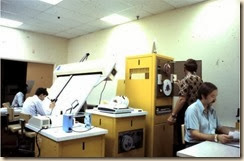 Almost thirty-five years ago, when I first started messing around with computers for a living, the company with which I was employed bought a giant Gerber CAD system. Seriously. The thing was huge. The CPU took up a large closet-sized metal rack, the D-size printer used pens for crap’s sake, the “memory” was reel-to-reel and almost stored enough information to draw a kiddies’ picture. The company’s CEO had seen a demonstration of the Gerber nightmare and, being the clueless little dork he was, put down his unearned million dollars for a pair of work stations. It was up to the Engineering Department to turn this horrible investment into something productive.
Almost thirty-five years ago, when I first started messing around with computers for a living, the company with which I was employed bought a giant Gerber CAD system. Seriously. The thing was huge. The CPU took up a large closet-sized metal rack, the D-size printer used pens for crap’s sake, the “memory” was reel-to-reel and almost stored enough information to draw a kiddies’ picture. The company’s CEO had seen a demonstration of the Gerber nightmare and, being the clueless little dork he was, put down his unearned million dollars for a pair of work stations. It was up to the Engineering Department to turn this horrible investment into something productive.
We failed. We failed miserably. It took an engineer and a draftsman hours to do the same work a draftsman could have done in a few minutes. A whole schematic took days. A mechanical drawing burned up lifetimes. Even more fun, the printing process would often crash the drawing and those hours, days, and lifetimes would start all over again. The CEO and his suited crowd of Yes Men often stood by the printer, proudly watching the damn thing pick pens and drag ink across paper. When the paper ripped or the pens started drawing gobblygook, the suits would scurry away like cockroaches when the lights come on. After a year of wrestling with finding ways to turn a few hours work into a month of misery, I quit and escaped to a small manufacturer where I hoped to never see a computer again.
Two years later, I was in California working for another small manufacturer. For the first year, I’d wrestled with the company’s Wang “word processor” and the god-awful database the CFO had begun in Wang Basic. He’d started with the wild hope that he could figure out the programming language, given up, hired a “consultant” who’d really made a mess out of the idea, given up again, hired me and assigned me with the task of making this mess work. With a $10,000 price tag on a new 5M hard drive, he’d convinced himself that it could be done with enough brilliant work. I was supposed to provide the brilliance.
 I cheated, eventually. Wang Basic wasn’t up to the task of providing a database that could manage our parts inventory and ordering system, our product BOM structure, and our produce revision history. So, I bought a brand new, post-bankruptcy, Osborne Executive, bootlegged a copy of DBase (for CP/M), created the BOM history with SuperCalc (came bundled with the Osborne), ported that to DBase, and began providing written inventory reports, purchasing schedules, and assembly documentation from DBase. Eventually, all of the company’s execs bought dirt cheap Osbornes from the local Xerox store and we all started using the same software. After a few years, we all moved over the DOS-based IBM AT-clone computers from a local company, AST Research (remember when American companies make computers? I do.). We upped our software game to FoxBase II, Supercalc II, Word, and, eventually, added design analysis and CAD to our systems.
I cheated, eventually. Wang Basic wasn’t up to the task of providing a database that could manage our parts inventory and ordering system, our product BOM structure, and our produce revision history. So, I bought a brand new, post-bankruptcy, Osborne Executive, bootlegged a copy of DBase (for CP/M), created the BOM history with SuperCalc (came bundled with the Osborne), ported that to DBase, and began providing written inventory reports, purchasing schedules, and assembly documentation from DBase. Eventually, all of the company’s execs bought dirt cheap Osbornes from the local Xerox store and we all started using the same software. After a few years, we all moved over the DOS-based IBM AT-clone computers from a local company, AST Research (remember when American companies make computers? I do.). We upped our software game to FoxBase II, Supercalc II, Word, and, eventually, added design analysis and CAD to our systems.
 All that harmony didn’t last long, though. Our marketing department, always looking for ways to blow money and exempt themselves from responsibility, responded to Apple’s bullshit “a computer for the rest of us” campaign and bought the biggest piece of shit ever foisted on the world as a “computer.” Suddenly, nothing could be done at that end of the company without consultants: computer consultants, marketing consultants, graphics consultants, artistic consultants, concept consultants, and management consultants. Since the Mac couldn’t talk to anything on the accounting, manufacturing, customer or billing, sales, or any other area of the company, marketing had successfully isolated itself from work. As far as I know, the company’s marketing department is still perfectly useless. Nothing in their advertising from the last 30 years proves otherwise.
All that harmony didn’t last long, though. Our marketing department, always looking for ways to blow money and exempt themselves from responsibility, responded to Apple’s bullshit “a computer for the rest of us” campaign and bought the biggest piece of shit ever foisted on the world as a “computer.” Suddenly, nothing could be done at that end of the company without consultants: computer consultants, marketing consultants, graphics consultants, artistic consultants, concept consultants, and management consultants. Since the Mac couldn’t talk to anything on the accounting, manufacturing, customer or billing, sales, or any other area of the company, marketing had successfully isolated itself from work. As far as I know, the company’s marketing department is still perfectly useless. Nothing in their advertising from the last 30 years proves otherwise.
Near the end of my time in California, a friend/employee was working on a show band project. He’d collected a group of wonderful musicians and singers, written several great R&B tunes, spent a butt-load of money on a sound system, and rehearsed the band until they were ready for a show case performance in front of some industry clowns. The problem was that he’d been reading too much Electronic Music bullshit and had bought into the idea that a Mac was a music machine and that Mac’s GUI-based MIDI software was the way to go for live performance. Remember, in 1990, the Apple Mac worked so slowly that it resembled Facebook’s crappy text editor in speed. Someone like me, who could type about 60w/m would be driven nuts by the Mac’s inability to keep up, on screen. If you foolishly watched the screen while you typed, you’d go crazy with the slowly crawling characters appearing seconds after you’d typed them.
After failing to be able to run his show by himself, my friend hired me to run FOH and run the MIDI show. I went to several practices, fought with the sluggish and unstable Mac and MOTU’s POS Digital Performer software, and pissed off everyone by my inability to keep the whole mess together; it was a 10-piece band sync’d to a glitchy Mac and MIDI. When we moved to a rehearsal hall, a couple of weeks before the performance, I suddenly “fixed” everything. I’d ported his Performer data to straight MIDI, moved that to a Compaq “portable” computer, loaded up Cakewalk (for DOS), and sync’d the live band to the MIDI performance coming from a Yamaha DX1 and my Kurzweil modules. My friend never knew that his Mac was no longer in the loop and the show came off fine.
Due to other issues, I’d pretty much exhausted my patience for Southern California by then and a few months later I left the state. He went back to trying to make the Mac drive the show and a few months later the band folded. Over the years, I’ve been amused to see Apple continuously turn simple stuff into massively unmanageable complexity and Apple’s Kool-Aid Kids have grown to be the largest cult outside of the Catholic Church. Even to this day, Microsoft is the primary reason Apple can still sell its overpriced, cluttered, unpredictable, trendy computers. You wouldn’t know it from the crazy stuff Apple’s Kiddies say, though. Listening to them, you’d deliriously imagine that Apple had done something other than exactly what my California company’s marketing department did; separate itself from actual work and redefine “function” as inept complexity.
Technorati Tags:
apple computer,
macintosh,
mac,
digital performer,
cakewalk,
MIDI,
compter,
management,
qsc audio products,
MOTU,
music,
performance



